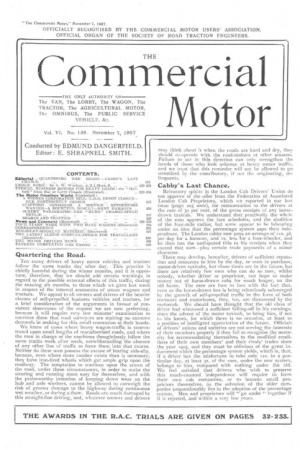Quartering the Road.
Page 1

If you've noticed an error in this article please click here to report it so we can fix it.
Too many drivers of heavy motor vehicles and tractors follow the same tracks day after day. This practice is chiefly harmful during the winter months, and it is opportune, therefore, that we should add certain warnings in regard to the possible external effects of this traffic, during the ensuing six months, to those which we gave last week in respect of the internal economies of steam wagons and tractors. We appeal to all owners and drivers of the heavier classes of self-propelled business vehicles and tractors, for a brief consideration of the arguments in favour of consistent observance of the request we are now preferring, because it will require very few minutes' examination to convince them that road surveyors are making no extreme demands in seeking for this small concession at their hands. We know of cases where heavy wagon-traffic is concentrated upon small lengths of macadamised roads, and where the men in charge of the machines thoughtlessly follow the same tracks week after week, notwithstanding the absence of any other line of traffic to force them into that course. Neither do these men possess the excuse of fearing side-slip, because, even where more camber exists than is necessary, they have iron-tired wheels which get ample grip upon the roadway. The temptation to continue upon the crown of the road, under these circumstances, in order to make the steering and running more easy for themselves, and with the praiseworthy intention of keeping down wear on the hub and axle washers, cannot be allowed to outweigh the risk of greater damage to the highway during continuous wet weather, or during a thaw. Roads are much damaged by this straight-line driving, and, whatever owners and drivers may think about it when the roads are hard and dry, they should co-operate with the road-makers at other seasons. Failure to act in this direction can only strengthen the hands of those who look askance at heavy motor traffic, and we trust that this reminder will not be allowed to go unnoticed by the contributory, if not the originating, delinquents.
Cabby's Last Chance.
Refractory spirits in the London Cab Drivers' Union do not approve of the offer from the Federation of Associated London Cab Proprietors, which we reported in our last issue (page 205 ante), for remuneration to the drivers at the rate of 30 per cent. of the gross receipts of any horsedrawn taxicab. We understand that practically the whole of the men approve the fare schedules, and the abolition of the four-mile radius, but some appear to be labouring under an idea that the percentage system saps their independence. The London cabby now pays an average of I is. 3d, per day for a hansom, and Is. less for a four-wheeler, and he then has the undisputed title to his receipts when they exceed that sum—plus certain trade payments of a minor character.
There may develop, hereafter, drivers of sufficient reputation and resources to hire by the day, or even to purchase, motor-driven taxicabs, but those times are. in the future, but there are relatively few men who can do so now, whilst nobody, whether driver or proprietor, can hope to make money out of horse-drawn cabs for much longer, on the old bases. The men are face to face with the fact that, even as the horse-drawn bus is being relentlessly submerged by the growth of self-propelled traffic in the form of both tramcars and motorbuses, they, too, arc threatened by the aintorcab. We should have thought that the old class of driver had witnessed a sufficient falling-off in his earnings, since the advent of the motor taxicab, to bring him, if not to his knees, for which there is no occasion, at least to a positioa of intelligent appreciation of the future. Officials of drivers' unions and societies are not serving the interests of their members properly if they fail to recognise the necessity for accommodating 'themselves to the modified conditions of their own members' and their rivals' trades since the year tgo5, and they must be oblivious of the great inducement which the percentage system yields, which is, that, if a driver has the misfortune to take only 12S. in a particular day, at least 35. of the sum, under the new system, belongs to him, compared with -nothing under the old. We feel satisfied that drivers who wish to preserve this much-vaunted independence will require to form their own cab companies, or to become small proprietors themselves, as the salvation of the older companies unquestionably lies in the adoption of the percentage system. Men and proprietors will " go under together if it is rejected, and within a very few years.
























